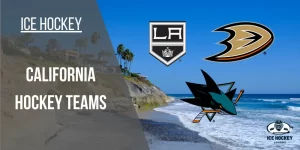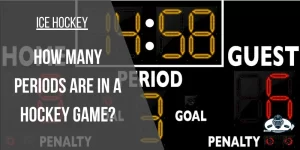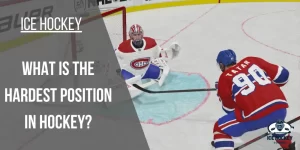Can you be in the Goalie Crease?

Have you ever thought that the rules of ice hockey might be a little complex to learn? The crucial of all these rules is to know when the players are allowed to enter the crease and when they are not.
So, can a player be in the goalie crease? There is no prohibition to entering and skating through a goalie’s crease for a player pursuing the puck. However, he cannot obstruct or hinder a goalie’s movement in a goalie’s crease because this will directly result in a two minutes goaltender interference penalty.
The goalie crease is the area where the players through the puck into the net to goal a score. Many misunderstood talks have been standard among the people about this area. And the action of players allowed in the goalie crease is a mystery. This article will clear all those mysteries about players getting into the goalie crease.
Table of Contents
Goalie crease and its purpose
The goalie crease is the shaded area right in front of the net where the player goal. This area is the standing place of hockey goalies where they stop the puck from the opposing team in the game.
However, the player from the opposing team is not allowed to interfere with the hockey goalie. There are specific rules to mark the crease; the crease is marked with red and filled with blue between the red boundaries of two inches. This is the primary focused area of the game court as the players rush to the crease every time any goal is scored, and the goaltender tries to stop the goal.
What are players allowed to do in the goal crease?
The people who think entering the goalie crease is prohibited for the players are not right. Following are the cases when the players are allowed in the crease.
Players can enter behind the goalie
Players are allowed to skate through the goalie creases. Many instances prove this claim. One is when the goalie takes a position on either side of the scoring net. Then the player can enter from behind the goalie and cut him through the back to avoid the puck getting caught by the goalie.
Players in the goalie crease are legal if they do not hinder the goalie’s actions and do not contact him in person. Otherwise, the hindrance will cost the player the penalty of two minutes under the goalie’s interference penalty.
Players can enter the crease chasing the bounced-back puck
The other case when players can enter the crease is when they are trying to overtake the puck that the goalie has not stopped. Goalies try to stop the puck from bouncing back to the opposing team and hitting the net. It happens a lot when the goalie tries to stop the puck, and in return, it bounces back to the opposite team of the goalie. This always creates terrible situations for the goalie’s team.
However, the goalies are trying to learn to avoid bouncing back, but it is difficult to stop as the players hit the puck with their sole might. Sometimes, the puck bounces back into the crease, and the players of the opposite team have the appropriate right to chase the puck and try to score a goal while chasing it.
Prohibited actions for players in the goalie crease
Players are not allowed to interfere with the goaltender or touch him. The people who think those players are not allowed some actions with the goalie in the crease are right in some cases. Following are the actions the players are not allowed to do in the crease.
Incidentally touching the goalie
If the player enters the crease and he incidentally impedes the goalie, then the referee is the person to decide whether it was an incidental touch or not. If the player accidentally enters the crease and stops the goalie from saving, the goal will be void.
Another case is commonly seen when the player from the same team as the goalie incidentally seeks into the goalie crease. In this case, the goal scored by the opposing team will not be void. Thus, we can assume that touching the goalie is an action that is not good for both teams, and the players should avoid it if they have any chance to slip into the crease.
Intentional touch with the goalie
Contrary to incidental touch with the goalie, another situation that is seen often is a player getting stuck with the goalie intentionally. In this case, the player will get a two-minute penalty during the goalie’s interference.
Intentional interference occurs when the players try to skate harder to get a position in front of the net but take the wrong turn and stick the goalie hard. This situation is terrible for the player and goalie as the player is bound to get the penalty as punishment and the goalie is more likely to get injured.
Moreover, players are more likely to enter the goalie crease and interfere with the goalie when a team player pushes his opponent. And the driven player falls into the crease and touches the goalie. The intentional touch is also for the referee to decide and give a penalty if the pushed player does not resist the push.
Furthermore, the incidental or intentional interference of the players with the goalie is decided by watching the video in the National Hockey League. Reviewing the video recorded during the match satisfies the audience, goalie, and team players. The referee also finalizes his decision after reviewing the video.
However, the video review is not the best solution in deciding the matter as the video results are not always satisfactory. Commentators, players, and the audience are always perplexed about the outcome regarding the penalties.
Can a goalie hit a player?
Goalies can hit the players if they try to stay safe from an interfering layer and follow the rules. The rules say that goalies in a hockey match can hit the player if they are not interfering or charging the players. A goalie can hit the player if they are holding a puck and are playing in the arena.
Frequently Asked Questions
Is there a penalty to hit or block a goalie outside of the goalie’s crease?
If a goalie is outside of his crease, then they can get hit or hindered by players. There is no direct penalty. It is on the referee to decide as per the situation. While if players are outside of the crease and the goalie is inside the crease, then there is a straight two minutes penalty.
Is a goalie allowed to get the player out of the crease?
Players are not allowed to hinder a goalie’s movement. So, if a player restricts his movement inside the crease, then a goalie can initiate contact with a player to push him outside the crease.
This will hint that a player is blocking a goalie’s movement, and if a player does not leave the place instantly, then there will be a two-minute penalty for him.
Can a player stay in the crease while scoring a goal?
Yes, there is no violation of rules in staying inside a crease when a goal is scored as long as all goal rules are fulfilled, with no goalie’s movement impeding.
Conclusion
This article cleared the myths about the players who can or cannot enter the goalie crease. We also learned about players’ allowed and prohibited actions in a goalie’s crease. Furthermore, the facts about the video reviews in NHL were discussed. We learned that the goalies could hit the players, but the players would get a penalty if they incidentally or intentionally hit the goalie. Thus, the goalie is the ‘King of the crease,’ and players must behave themselves when roaming around his castle.
Related Posts:

Who is Austin Taylor?
Meet Austin Taylor, your go-to source for everything ice hockey! With a passion for the sport that’s as deep as the ice itself, Austin Taylor brings you concise, expert insights and nitty-gritty details on all things hockey. From gear reviews to strategy breakdowns, Austin Taylor is your trusted guide to navigating the exhilarating world of ice hockey. Get ready to lace up your skates and dive into the game with Austin Taylor as your ultimate companion.




